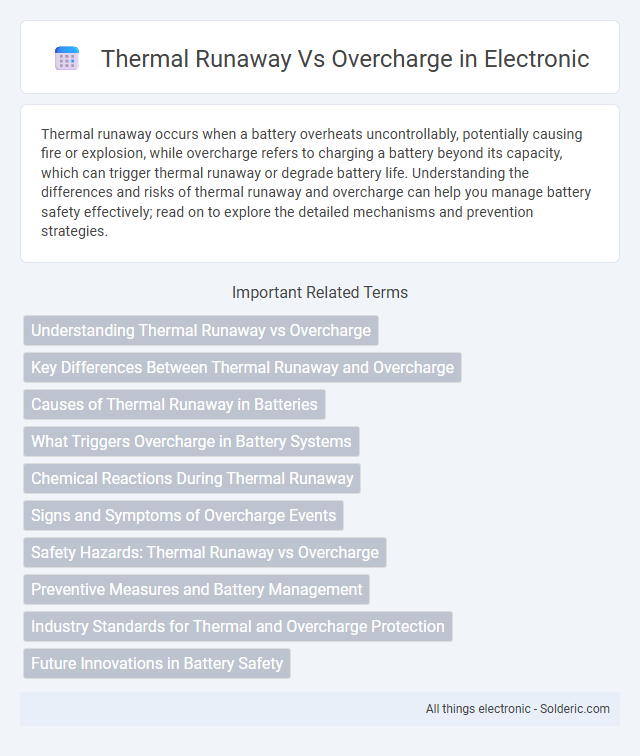Thermal runaway occurs when a battery overheats uncontrollably, potentially causing fire or explosion, while overcharge refers to charging a battery beyond its capacity, which can trigger thermal runaway or degrade battery life. Understanding the differences and risks of thermal runaway and overcharge can help you manage battery safety effectively; read on to explore the detailed mechanisms and prevention strategies.
Comparison Table
| Aspect | Thermal Runaway | Overcharge |
|---|---|---|
| Definition | Uncontrolled temperature increase causing battery failure. | Charging a battery beyond its maximum voltage limit. |
| Cause | Internal short circuit, high temperature, mechanical damage. | Excessive charging current or voltage beyond specification. |
| Effect | Rapid temperature rise, gas release, fire, explosion risk. | Battery swelling, capacity loss, potential overheating. |
| Detection | Temperature sensors, voltage irregularities, gas sensors. | Voltage monitoring, current control, battery management system (BMS). |
| Prevention | Thermal management, quality materials, safety vents. | Proper charger settings, BMS regulation, charge cut-off. |
| Impact on Battery Life | Permanent damage, risk of total failure. | Reduced cycle life and capacity degradation. |
Understanding Thermal Runaway vs Overcharge
Thermal runaway occurs when excessive heat generation in a battery causes a self-sustaining reaction, potentially leading to fire or explosion, while overcharge refers to charging a battery beyond its maximum voltage limit, causing damage to its internal chemistry. Understanding the distinction is crucial for battery safety management, as overcharging can trigger thermal runaway by increasing internal pressure and temperature. Effective battery management systems (BMS) monitor voltage and temperature to prevent overcharge conditions and mitigate risks of thermal runaway events.
Key Differences Between Thermal Runaway and Overcharge
Thermal runaway occurs when excessive heat generation within a battery causes a self-sustaining increase in temperature, leading to potential fires or explosions, whereas overcharge happens when a battery is charged beyond its maximum voltage capacity, risking electrolyte breakdown and reduced battery life. Thermal runaway is a critical safety hazard driven by internal chemical reactions, while overcharge primarily affects battery performance and longevity. Understanding these differences is essential for implementing proper battery management systems and safety protocols.
Causes of Thermal Runaway in Batteries
Thermal runaway in batteries is primarily caused by internal short circuits, overcharging, and exposure to high temperatures, leading to uncontrolled heat generation and potential fire hazards. Overcharging forces excessive current into the battery, increasing chemical reactions and internal pressure, which can trigger thermal runaway. Understanding these causes helps you prevent dangerous battery failures and maintain safe battery operation.
What Triggers Overcharge in Battery Systems
Overcharge in battery systems is primarily triggered by charging voltages exceeding the manufacturer's recommended limits, leading to excessive current flow and cell stress. Faulty battery management systems (BMS) and improper charger calibration can fail to regulate voltage and current, causing the battery to absorb more charge than designed. Elevated temperatures and compromised cell chemistry further exacerbate overcharge conditions, increasing the risk of thermal runaway.
Chemical Reactions During Thermal Runaway
Thermal runaway involves exothermic chemical reactions within the battery, where increased temperature accelerates electrolyte decomposition, separator melting, and anode-cathode reactions, leading to rapid temperature rise. Overcharge triggers excessive lithium plating and electrolyte breakdown, which can initiate thermal runaway if unchecked. The self-reinforcing heat generation during thermal runaway causes internal short circuits and gas release, posing significant safety hazards.
Signs and Symptoms of Overcharge Events
Overcharge events are characterized by abnormal battery swelling, increased temperature, and electrolyte leakage, signaling critical stress on the cell. Visible deformation of the battery casing and persistent voltage rise beyond manufacturer specifications further indicate overcharge conditions. Early detection through these signs is crucial to prevent escalation into thermal runaway, which involves uncontrollable temperature spikes and potential combustion.
Safety Hazards: Thermal Runaway vs Overcharge
Thermal runaway and overcharge both pose significant safety hazards in battery systems, but thermal runaway involves an uncontrollable increase in temperature that can lead to fires or explosions, whereas overcharge primarily causes excessive heat and pressure buildup within the cell. Your battery's internal structure can deteriorate rapidly during thermal runaway, resulting in catastrophic failure, while overcharge stresses the battery by forcing it beyond its voltage limits, increasing the risk of electrolyte leakage and thermal instability. Proper monitoring and protective circuits are essential to mitigate these risks and ensure safe operation.
Preventive Measures and Battery Management
Effective battery management systems (BMS) employ precise voltage and temperature monitoring to prevent thermal runaway and overcharge conditions by regulating charge rates and activating cut-off mechanisms. Incorporating high-quality cell balancing and advanced cooling systems enhances preventive measures by maintaining uniform cell performance and dissipating excess heat efficiently. Regular firmware updates and adherence to manufacturer-recommended charging protocols further optimize battery longevity and safety by minimizing risks associated with overcharging and thermal instability.
Industry Standards for Thermal and Overcharge Protection
Industry standards such as UL 1642 and IEC 62133 specify stringent thermal and overcharge protection requirements to ensure battery safety in consumer electronics and electric vehicles. These standards mandate the use of thermal cutoff devices, current interrupt devices, and sophisticated battery management systems (BMS) that monitor voltage, temperature, and current to prevent thermal runaway and overcharge conditions. Compliance with these standards reduces risks of fires and explosions by enforcing robust design, testing, and certification protocols for lithium-ion battery packs.
Future Innovations in Battery Safety
Future innovations in battery safety target preventing thermal runaway and overcharge through advanced materials and smart management systems. Solid-state electrolytes and enhanced separator technologies reduce the risk of overheating and chemical reactions that cause thermal runaway. Your devices will benefit from real-time monitoring and AI-driven controls, ensuring safer and longer-lasting battery performance.
Thermal runaway vs overcharge Infographic

 solderic.com
solderic.com